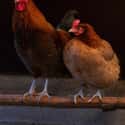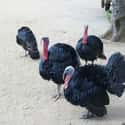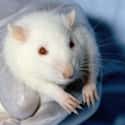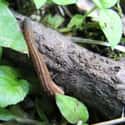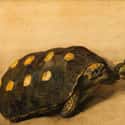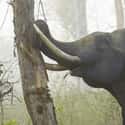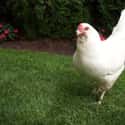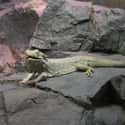-
(#1) Stockholm University Conducted A Study That Proves Chickens Don't Like Ugly People
Dr. Stefano Ghirlanda of Stockholm University's experiment rests on the understanding that when a chicken pecks a photograph of a person, they do so because they find said person attractive. Chickens seem to be largely heterosexual as determined by step one of the process. Individual chickens were first shown a picture of a human male and one of a human female. The hens usually pecked the men, while the cocks pecked the women. Then the chickens were presented with seven different images of people, the same images college students were given to rate 0-10 in terms of attractiveness.
Roughly 98% of the time, the chickens pecked the most attractive person in accordance with the students' ratings.
-
(#2) Dr. Robert E. Cornish Brought Dogs Back To Life In The '30s Using Seesaw Technology
Dr. Robert E. Cornish was a University of California-Berkeley grad who wished to master death. He unsuccessfully attempted this with humans, so he tried with dogs. He actually did see success there. On two occasions, he managed to bring dogs back to life that had just been killed via nitrogen gas suffocation. After the dogs were dead, Cornish fixed the dogs to a seesaw and began lifting them up and down to circulate blood flow while injecting them with anti-coagulants and epinephrine. The dogs returned to life and went on living.
After his dog success, Cornish wanted to try his method on a human once again. A death row inmate named Thomas McMonigle offered his body for experimentation post-execution, but the state of California wouldn't allow it, fearing the murderer would be immune to further prosecution if returned to life via the double jeopardy clause.
-
(#3) Penn State Scientists Studied Turkey Sexuality By Seducing Males With Parts Of A Female
“Stimulate Eliciting Sexual Behavior” was the title of the study done by Dr. Martin Schein and Dr. Edward Hale of Penn State University on turkeys' mating preferences. They wanted to determine whether or not male turkeys are ready to procreate, even if their object of desire is just the severed head of a female. The scientists wanted to see precisely what got a tom turkey's engine revved, so they started with a completely intact (but dead and stuffed) female turkey, then tried removing various parts and documenting the males' level of interest. Apparently, male turkeys are less inclined to mate with a headless female's body than the opposite, as they were more interested in copulating with the severed head.
The scientists concluded it was the neck that was the deciding factor. While trying the same experiement with chickens, they found the exact opposite was true: they prefer headless bodies as sexual partners.
-
(#4) Science Taught Us Rats Prefer Jazz Over Beethoven, But Only If They're On Cocaine
If rats are going to be subjected to music, they prefer Beethoven over jazz. Albany Medical College made these findings in the course of their research, but they further discovered they could change those rats' preferences.
If rats were injected with cocaine, they suddenly enjoyed Davis's jazzy number, "Four." Even after the cocaine was out of their system, those injected with it preferred that song going forward over "Für Elise."
-
(#5) Norwegian Scientists Discovered Drunk Leeches Are Less Capable Of Sucking Blood
Anders Baerheim and Hogne Sandvik of the University of Bergen in Norway hypothesized leeches would more effectively suck blood if they were dunked in beer first. They were wrong. The exact opposite was true - drunk leeches weren't able to suck blood at all.
They also tested the effects of sour cream and garlic on leech sucking abilities, discovering that sour cream was the magic substance, as it made leeches better suckers. Garlic just killed the leeches.
-
(#6) In 2011, A British Scientist Spent Six Months Teaching A Tortoise To Yawn
Anna Wilkinson of the University of Lincoln in the UK has a pet tortoise named Moses, and she has studied him for years, putting him up to all kinds of tests. In 2006, she proved Moses was more capable of navigating a maze than mice and rats. And now Moses can yawn. Wilkinson taught Moses to yawn in an effort to study the "contagiousness" of yawning and whether or not it's related to empathy. She did this to challenge the theory the contagiousness of yawns is a result of human empathy; since tortoises lack empathy, if they also displayed contagious yawning, it would dispel that theory.
Unfortunately, while Moses learned to yawn, it did not spread among his tortoise friends. We still don't know if yawns are contagious because of empathy.
-
(#7) An Elephant Died Of An LSD Overdose In This 1962 Experiment
Dr. Louis Jolyon "Jolly" West ran the 1962 experiment on an elephant named Tusko, whom he and his colleagues murdered. West's aim was to determine if LSD could induce a natural state in a bull elephant called "musth," which "is a period of heightened testosterone production and high aggression," according to The Guardian.
West and his cohorts injected Tusko with 297mg of LSD, way too much even for a three-ton elephant (a human of that size would still be flying high on 10mg). But it probably wasn't even the acid that killed Tusko. West overcompensated by pumping the elephant with too much Thorazine, an anti-psychotic. He then followed up with a tranquilizer. Tusko died one hour and 40 minutes after the initial dose of LSD. The Guardian claims West has been linked to the CIA's MKUltra program, which involved illegal experimentation on unwitting humans to see if mind control was possible.
-
(#8) The University Of Minnesota Determined Swimming In Syrup Is No More Difficult Than Swimming In Water
Edward Cussler, who oversaw Michael Hopkins's 2004 experiment at the University of Minnesota, admitted that "the bizarreness of the idea," is a reason it received funding. Sixteen people of varying swimming skills swam in a regular pool and a pool of guar syrup, which is twice as thick as water. The differences in their recorded times were negligible.
-
(#9) In 2016, Scientists Grew A "Dinosaur-Like" Leg On A Chicken
Brazilian researcher Joâo Botelho discovered he could produce a chicken with a fibula comparable to that of dinosaurs', but to appropriate chicken-scale. Basically, it's a chicken with an extra bone in its leg. The gene involved in the process is called the Indian Hedgehog (IHH), a bone maturation gene.
By inhibiting this gene, chickens will apparently grow a larger, tubular fibula.
-
(#10) This Study Determined Precisely How Far Penguins Project Their Poop
Victor Benno Meyer-Rochow and Jozsef Gal, German and Hungarian researchers, respectively, went on an Antarctic expedition to determine how far penguins project their feces. The two researchers went to Antarctica to observe penguins with the sole mission of measuring just how apt the term "poop shoot" is vis-a-vis penguin defecation. A 60-cm-tall penguin can launch its feces 40 cm.
Penguins do this in order to keep it away from their nests.
-
(#11) We Now Know Pigeons Can Tell The Difference Between Good And Bad Paintings By Children
The quality of children's paintings vary quite drastically, and it's that variance Shigeru Watanabe, a psychologist at Keio University in Tokyo, taught pigeons to recognize. This is actually a continuation of Watanabe's work, who taught pigeons to discern Picasso paintings from Monet's in 1995.
In 2010, he taught pigeons to judge the works of children between the ages of 9-11, to "grasp the human concept of beauty" by discerning between "crude" and "well-executed" paintings. The pigeons actually concurred unanimously with a panel of 10 adults on which paintings were "good" and which were "bad" in line with the grades the paintings received in the kids' art classes.
-
(#12) A Stingray Robot Powered By Rat Cells Was Created In 2016
Harvard bioengineer Kit Parker wanted to see if he could power a robot stingray with light-powered heart-cells of rats instead of electricity. The experiment was costly, as the first stingray skeleton-bot was made of pure gold.
Parker discovered that rat heart cells can indeed power a robotic stingray sans electricity. The video above proves it.
-
(#13) Science Determined Why Bearcats Smell Like Popcorn
Many people who have encountered bearcats have noted that the animals smell like movie theater popcorn, and a study provided the answer as to why. The Carolina Tiger Rescue, a nonprofit wildlife sanctuary in Pittsboro, NC, put the matter to rest once and for all. While their predecessors studied the creatures' scent glands to try to find the source of the popcorn smell, the people at the Carolina Tiger Rescue were the first to test bearcat urine.
It turns out a chemical compound called 2-acetyl-1-pyrroline, or 2-AP, is secreted in their urine. The compound 2-acetyl-1-pyrroline is the same compound that gives popcorn its signature smell. This smell is actually produced in the popping process, so it's inherent in the corn.
-
(#14) A German Researcher Determined Bearded Dragons Dream
Gilles Laurent of the Max Planck Institute for Brain Research in Frankfurt, Germany, determined that bearded dragons do, in fact, dream. While the human sleep cycle (or REM cycle, more colloquially) lasts 60-90 minutes, that of bearded dragons is only about 80 seconds long.
-
(#15) A 21st Century Study Tried To Determine If Fans Help In Extreme Heat And Humidity
Ollie Jay, Ph.D. of the University of Sydney wished to dispel the public health guidance that electric fans are actually dangerous in extreme heat. Jay and his colleagues tested 23-year-old men by putting them in temperature-controlled rooms, starting with temps at 97°F and 25% humidity and working up to 108°F with 70% humidity.
They measured heart rate and core temperature with and without the presence of electric fans to cool the subjects. They found that electric fans cooled the subjects.
New Random Displays Display All By Ranking
About This Tool
In the history of biological evolution on the earth, the reason why humans can be completely distinguished from animals is that humans have autonomous consciousness and wisdom, and humans can understand the world and develop themselves through various experiments. Over the centuries, humans have done many weird, meaningless and even wrong experiments in the process of exploring science and discovery.
Science is the key to advancing the development of human society, and mankind has never stopped exploring unknown areas. The random tool introduced the 15 weirdest scientific experiments that you never know. Welcome to search for other hot topics in this random tool.
Our data comes from Ranker, If you want to participate in the ranking of items displayed on this page, please click here.











